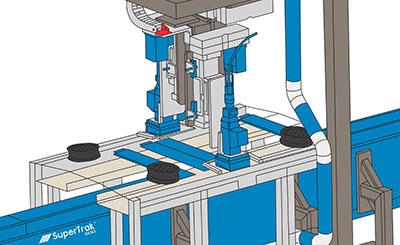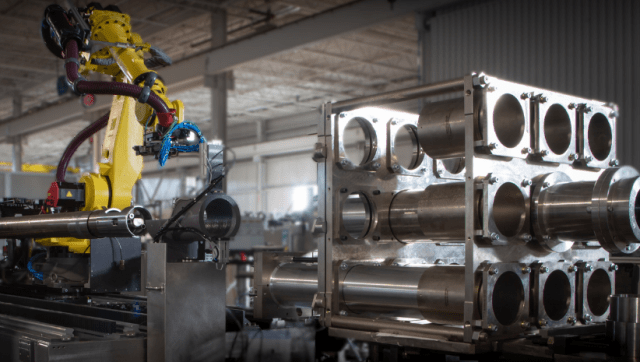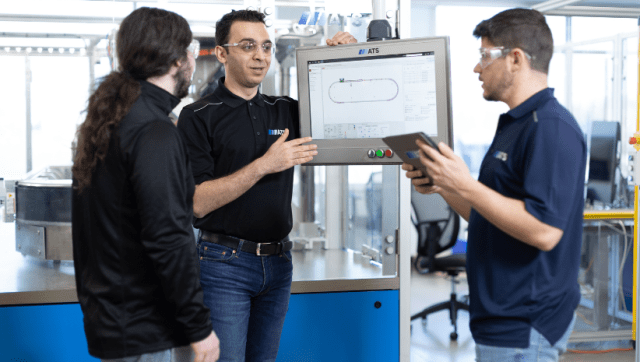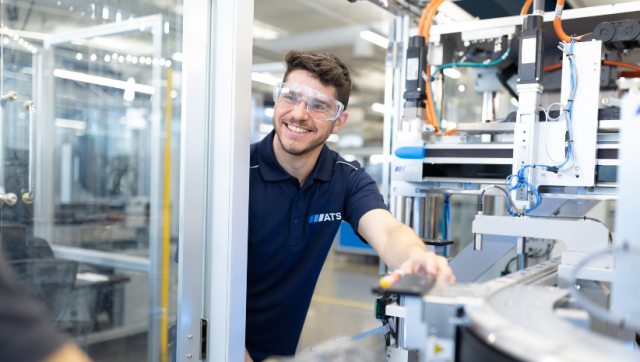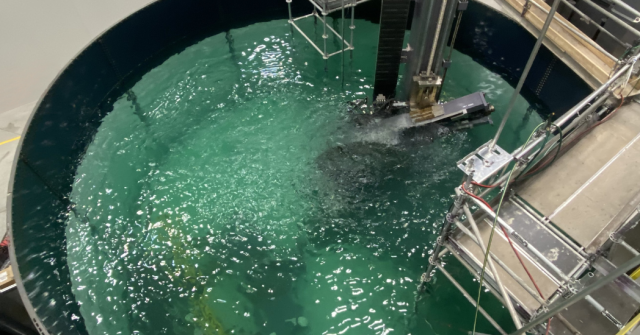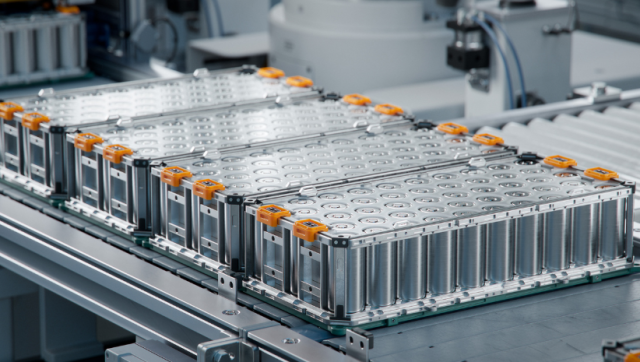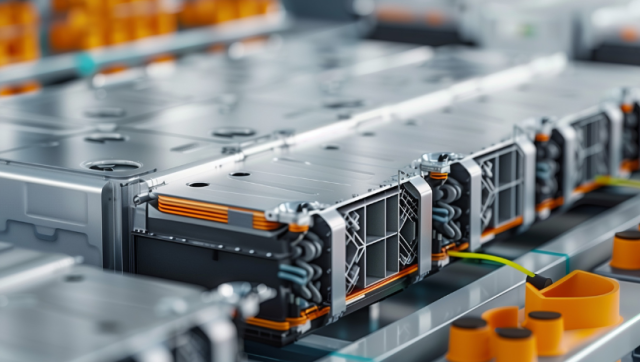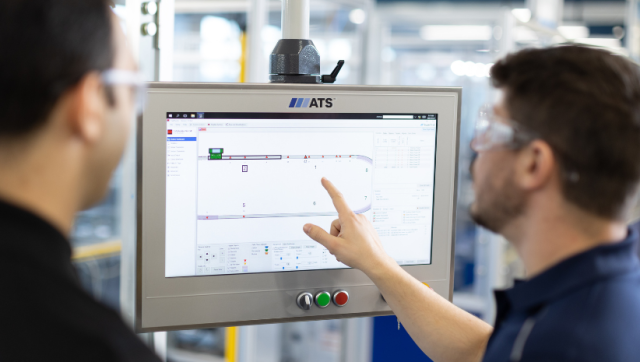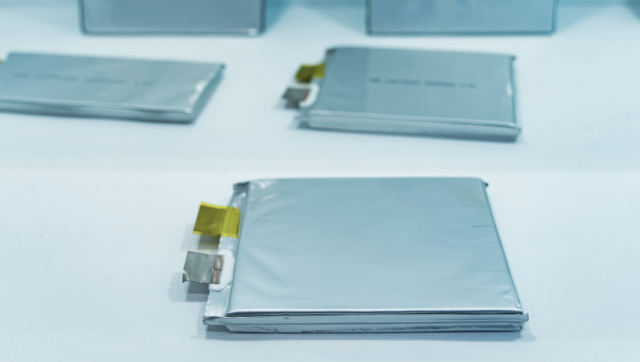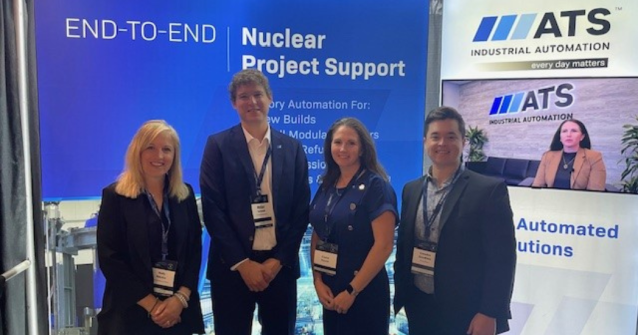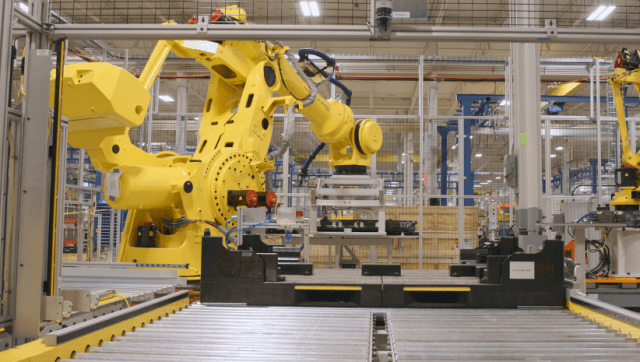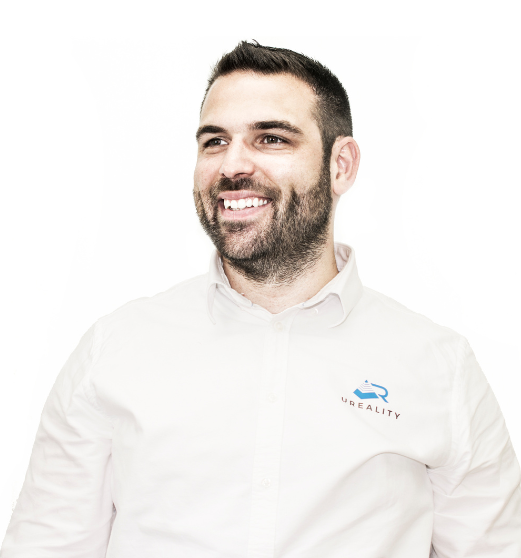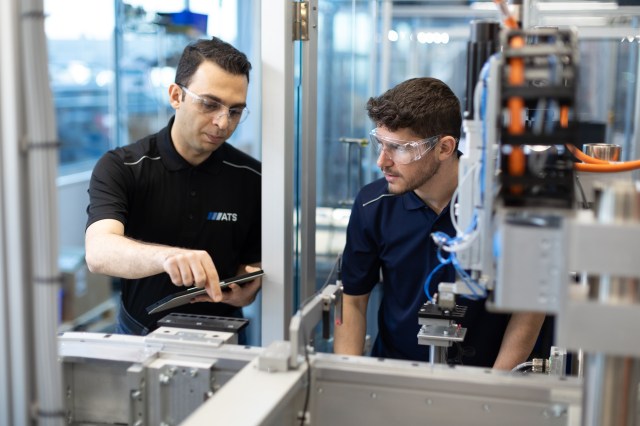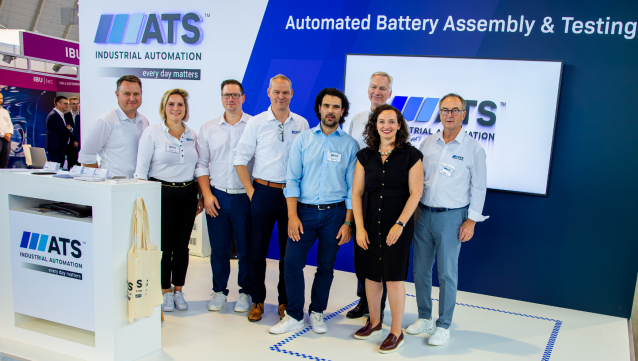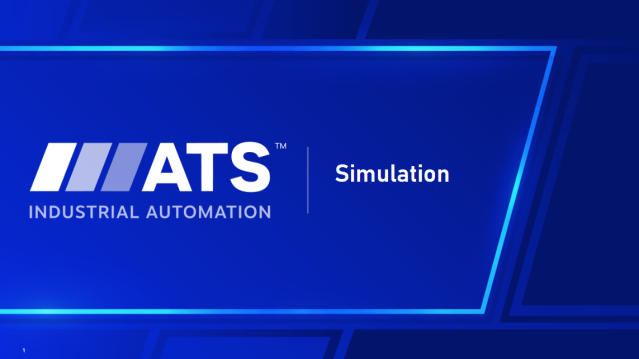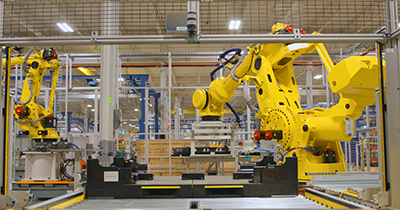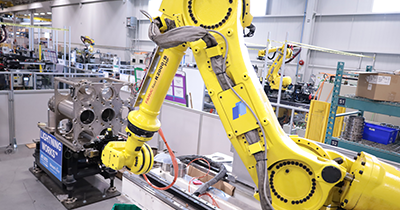24. October 2021
Konsumgüter und Industrieprodukte können in den USA montiert werden. In dieser hochgradig interaktiven Präsentation erfahren Sie, weshalb sich die flexible Hochgeschwindigkeits-Montageplattform Symphoni™ hervorragend für die schnelle Montage von Kleinteilen eignet. Anhand von Beispielen aus der Praxis erfahren Sie, welche Vorteile und Nachteile der Einsatz von Symphoni™ im Vergleich zu herkömmlichen Hochgeschwindigkeitsmontageverfahren mit sich bringt.
In dieser Aufzeichnung von der ATS Virtual Expo 2021 erklären Peng Cau und Christopher Spayd Folgendes:
- Die Vorteile von Symphoni™ im Vergleich zu kurvengesteuerten, rundtaktbasierten und kontinuierlich arbeitenden Ansätzen.
- Wie Unternehmen schneller vom Prototyp zur vollständigen Produktion gelangen können.
- Wie der Einsatz flexibler Hochgeschwindigkeits-Montageautomatisierung Ihnen einen Wettbewerbsvorteil gegenüber herkömmlichen Maschinen verschafft.
Schauen Sie sich jetzt das Webinar „Hochgeschwindigkeit und Agilität bei der Montage von Konsumgütern“ an
HINWEIS: Das Video ist auf Englisch
Referenten
Referent
Peng Cau
Vice President, Symphoni™.
Referent
Christopher Spayd
Sales Manager, ATS Industrial Automation.
Transkript
Peng Cau
Ladies and gentlemen, my name is Peng Cau. Welcome once again to the ATS virtual fair. I’m excited to speak with you about how manufacturing consumer packaged goods is changing and changing fast, as well as the incredible opportunities that are contained within this change.
Some of you may have already seen my talk at the virtual fair about how agility wins the race, in my panel discussion with ATS, President of Life Sciences, Chris Hart, and Senior VP of After Sales and Services, Simon Roberts, on the future of automation. If you haven’t, I recommend you take a look at both, because we address the high-level trends that face all manufacturers today, and how companies can take advantage of these global disruptions.
In this presentation, I want to talk about a transformative assembly automation technology that we call Symphoni™, which addresses these challenges. Following my portion of this presentation, you’ll be hearing from my colleague, Christopher Spayd, sales manager at ATS. He’ll be talking about how Symphoni™ transforms manufacturing lines from dedicated underutilized machines, to versatile multi-purpose assets. Symphoni™ can be configured for many products and processes. It is an exciting technology, especially when you think of what we can do to reduce your operating expenses and increase the speed to market with new product introductions.
The Origins of Symphoni™
Now, I’d like to tell you a little about me and my story. I am the VP of ATS Life Sciences for Emerging Markets and Symphoni™. Before I joined ATS, I ran an automation firm for twenty years, we custom designed and built continuous and indexing motion machines before we developed the patented technology that would become Symphoni™. The birth of Symphoni™ really started with sugarcane seed. Confused? Let me explain.
In 2009, my former company was hired by a multinational agribusiness firm to design an automation system that could cut sugarcane seeds at a rate of 600 parts per minute. We quickly realized that we had to build something that was flexible, because sugarcane stalks change with the weather, in unpredictable ways. It had to be precise in order for the sugarcane seeds to remain intact through the process. And of course, it had to be fast, because the client wanted to reduce the number of equipment due to the factory floor constraint. So, we couldn’t just build a one-size-fits-all system, because it wouldn’t work with the variations that Mother Nature threw at us, and we couldn’t build overly complex machines because the interface had to be intuitive and easy to use for unskilled operators. Instead, we invented a technology that provides speed, precision, and flexibility without compromise. This knowledge was a seed that eventually led the development of our patented Rapid Speed Match (RSM) technology in 2012, which is the core innovation of Symphoni™.
It didn’t take long for us to realize the huge opportunity. What product or process could have more variation than Mother Nature? The answer is nothing. Since we were able to conquer what Mother Nature threw at us, why not apply the principle of speed matching and synchronous motion to the assembly of lipstick, nail polish, toothbrush heads, inhalers, electrical connectors, razors, you get the idea. It’s pretty much products that have small, discrete components, that fit in your palm, that need to be assembled.
Each generation of Symphoni™ has addressed the limitations with conventional assembly technologies, from continuous motion to indexing motions, to pallets and robots. Today, after five generations, multiple patents and machines sold across four continents, Symphoni™ gives you the benefit of all conventional assembly technologies without their limitations.
Why Symphoni™ is Your Ideal Solution
But why? Why would a standardized pre-engineered assembly automation platform like Symphoni™ benefit your organization? What’s the problem with custom-designed, custom-built automation solutions that predominate the market today? Here’s a big number $4 trillion. That’s how much money was potentially lost to supply chain issues by US and European companies in just the first year of the pandemic. The numbers you see in this slide are from a McKinsey and Company report, which shows the vulnerability of global supply chains, not just to COVID-19, but to future shocks, some of which we can predict and plan for, and others we can’t. But here’s the takeaway from the McKinsey Report: companies and governments see COVID as an accelerator, not a blip. These disruptions will ebb and flow over the coming decades, but they will not disappear.
On the supply side, if one factory or one region is disrupted, unique flexible equipment in other places pick up the slack. On the demand side, if consumer behavior changes rapidly, which it does all the time, and at an increasing rate, then you need flexible equipment, which can take on new processes and new products, with minimal adjustment and time expended. This is what Symphoni™ is all about. You don’t have to give up speed for flexibility, nor should you give up flexibility for speed. Customers want their product when they want it. They want it unique to them, and they want it fast, and so should you if you want to win.
Symphoni™ combines the speed of palettes and robots with the high productivity only realized previously with custom continuous motion machines. With Symphoni™ you don’t have to choose; you can have both. Because Symphoni™ is fast and flexible, one machine can take on multiple processes and products. Symphoni™ is an assembly asset that can run 24/7, similar to injection molding machines. This reduces your physical footprint and operating expenses while optimizing your capital investment. And, because a Symphoni™ machine is configured from standardized modular building blocks, your machine purchase cycle is significantly reduced. Symphoni™ is easy to operate and maintain. All adjustments can be done on the HMI. As you invest in more and more Symphoni™, you will reduce your spare parts inventory and maintenance costs.
Symphoni™ is a digital technology. The process in a Symphoni™ machine is the same as your current trusted process, except that the mechanical cam is replaced by an electronic cam. In short, you can skip many of the obstacles that plague custom automation. Too often, these kinds of obstacles cause the introduction of a new product to fail. Instead, Symphoni™ is versatile, but uncompromisingly fast. It is elegant in its simplicity but allows for complex assembly processes. It is high-performance with a small footprint, and it speeds up time to market while reducing operating expenses and capital costs.
Imagine a custom automation solution for the assembly of soap dispensers. You go through all the hoops of many months to custom design and build a perfect machine. Your sales team gives you an annual sales projection for the next few years. From your experience, you know you have to buy a machine with a capacity that can meet the highest projected volume. However, during the prototype phase, you send the assembly process to a cheap labor country to be assembled by hand. In a best-case scenario, as your production is ramping up, your machine builder delivers your customer’s sewing machine on time, and you’re able to meet your product launch date and meet the sales volume your sales team predicted.
But what happens to that machine as the product matures and sales start to decline? You have an expensive asset that’s underutilized and taking up expensive floor factory space. With Symphoni™ you can start with one module, which we call Sonata™, to prove out your production process during your prototype phase. You can continue to use a Sonata™ cell for market testing. As your product proves successful, you add additional modules to configure a full Symphoni™ machine. As the product matures, you add new tooling for additional products. Thus, Symphoni™ is like your injection molding equipment, which depreciates over the life of the machine and not written off over the life of your product. It is a flexible depreciable asset that never sits idle. It can run 24/7, by running multiple products or processes. You will never gather dust in a corner because you can change the tooling or reconfigure the module as your business changes.
Symphoni™: Three Main Benefits
So, let’s recap. Symphoni™ offers three main benefits.
1. Ensuring your product development process, including manufacturing, validation, and approval, thus improving time to market.
2. It lowers your capital costs by leveraging your investment from product development to production, eliminating duplication while maximizing your asset utilization.
3. And it reduces the price per part through lowering your labor and operating expenses.
Those are the top line tangible benefits, but Symphoni™ offers your business one other thing in the face of a rapidly changing world. You can call it resilience, or flexibility, or from my speech about global trends, agility. But for the sake of this presentation, the word we want is opportunity.
Chris, over to you.
Use Case 1: Deodorant Dispensing
High-Speed Output & Flexibility Vs. Cam Driven Solutions
Christopher Spayd
In this use case, a contract manufacturer needed to reassure their production of soap dispenser assemblies. The traditional solution for this type of assembly is continuous motion equipment. However, given the nature of contract manufacturing and the customer’s production ramp, the utilization of a continuous motion machine would be extraordinarily low. The use of Symphoni™ would permit the contract manufacturer to fill the excess capacity of the equipment, which is inevitable during the initial product ramp, with a supplemental product, thereby increasing their profitability. This production layering is enabled by lower tooling cost of Symphoni™, the flexibility of the servo-controlled assembly systems and the user level programmability of the system.
Symphoni™ inherently has lower tooling costs than continuous motion systems. For example, a typical assembly station on a continuous motion machine may have a dozen or more of the same tool for the same operation. Symphoni™ in this case has only two. Therefore, to make the system capable of two products, that continuous motion system would require twelve or more tools to be changed or replacing the entire module. Symphoni™ can be changed with simple replacement of two pick heads, the RSM disc and a selection on the HMI. Symphoni™ accomplishes all of this with a much smaller footprint.
In this use case, ATS considered a traditional cam driven solution versus the Symphoni™ platform. This dispenser, as you can see in the sample image to the left, includes a thumb wheel and a driveshaft to raise the product as needed. Due to the complex insertion process for the driveshaft, the cam driven assembly solution would require a slower motion profile, and therefore would have a lower overall system throughput. On Symphoni™, the insertion process could be executed at a higher rate of speed, and not become the bottleneck for the assembly operations. While the cam driven solution would ultimately meet the customer’s throughput requirements, because the Symphoni™ machine was able to achieve a much higher throughput, the machine would have available capacity for other product. The contract manufacturer recognized the ability to take on new projects using the additional capacity of the Symphoni™ machine, as noted by the standby feeders and the layout in the middle of the page. This additional capacity and the relatively low cost to retool or dual tool a Symphoni™ machine, allowed the manufacturer to consider bidding on contracts that they would otherwise not take on due to higher CapEX costs.
Use Case 2: One High-Speed Symphoni™ vs Three Independent Lines
In this example, a manufacturer of value-added plumbing fittings is expanding production capacity. Their traditional approach is to have a speed matched assembly machine behind their molding process. The assembly and inspection processes are not well-suited to synchronous assembly systems, as some of the operations require three or four times the tack time of production to complete their operations. This forces the manufacturer to have three or four of every process tool on the machine chassis. In addition, because the assembly system is directly coupled to the molding process, utilization of the assembly system would be lower than ideal.
The Symphoni™ solution for this application would require only one machine to replace three of their traditional assembly machines. In addition to the tremendous floor space savings, the asynchronous nature of the Symphoni™ chassis permits reducing the number of process stations to a minimum number based solely on that process alone. For example, what would be a three or four uptooling nest on a synchronous chassis can be reduced to one nest. This permits reduction in the quantity of expensive process stations such as laser markers, vision systems and leak testers.
Use Case 3: Higher-Speed Production
In this use case, a manufacturer of a stopcock assembly shown on the left was running production with a traditional dial system. The manufacturer was looking for ways to reduce labor content, and asked ATS to consider upgrading that dial system to permit a lights-out operation. While this is certainly achievable, the sheer size of the incoming part feed hoppers was rather impractical and costly. Symphoni™ provides a unique solution to the situation. By achieving 24 hours’ worth of production in a single shift, the manufacturer would no longer need to staff the department on second and third shift, while offering a rather small footprint as shown in the middle of the slide. Due to the flexibility and lower tooling cost of Symphoni™, the manufacturer would now have two additional shifts for production of another product. While this is indeed a unique situation, this highlights the high speed and flexible nature of Symphoni™.
Use Case 4: Replacing Three Cam Driven Machines
In this final use case, a major manufacturer of household cleaning products recognized the flexibility of Symphoni™ for increasing equipment utilization and adapting to market changes. The manufacturer was using a dedicated dial assembly system for this three-piece actuator assembly, as you see on the left. While it’s a relatively stable product, the manufacturer has experienced significant tooling costs and production interruptions for adapting to ever changing customer demands. By switching to the Symphoni™ chassis, the manufacturer not only improves asset utilization by running multiple products on the machine, but they will also be able to adapt much more quickly to market demands, and at a lower cost.
Symphoni™: Proven Results to Scale Your Business
Peng Cau
Symphoni™ is a patented, proven, high-performance, flexible assembly platform for small, discrete parts. For over nine years, we have revolutionized assembly automation around the world. What processes and products could Symphoni™ do for you? What doors could it open for your business? What opportunities are baked into this technology that we haven’t considered yet? I would love to hear from you. Thank you very much.
Narrator
Our growing business needs a new automated assembly line. What are our options? Our factory floor is already tight. Management doesn’t want to see idle equipment, so we need to find a solution that maximizes productive capacity. If we select an adaptable solution, we could consolidate other production onto this new line and retire old lines. And an adaptable solution would accommodate future products. R&D already said a new product is on the way. The sales forecast is strong, we’ll need high-throughput assembly line automation. To meet the forecast, time to commercial production is critical. We need a line ASAP. Standard pre-engineered equipment would save us time and money and reduce our project risks. Wow. Symphoni™ meets all our requirements and more. The management team needs to hear about this disruptive technology from ATS. Contact us today to learn more.
Jedes Projekt ist einzigartig. Wir möchten uns Ihre Herausforderungen anhören und Ihnen mitteilen, wie Sie Ihr Projekt durch Automatisierung rechtzeitig auf den Weg bringen können.














